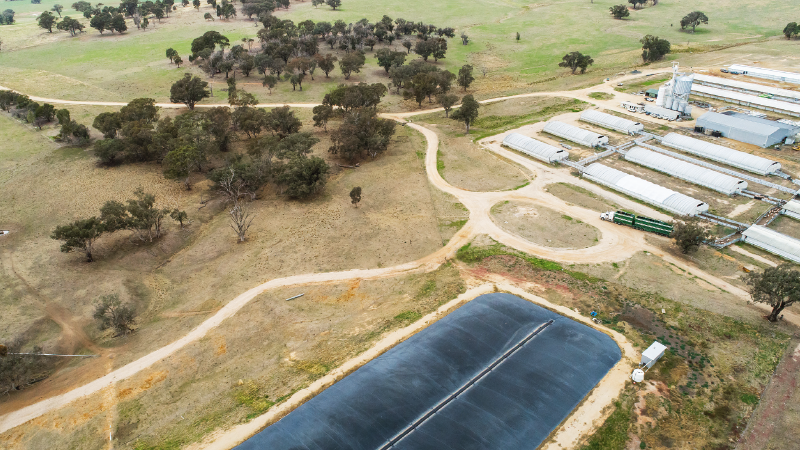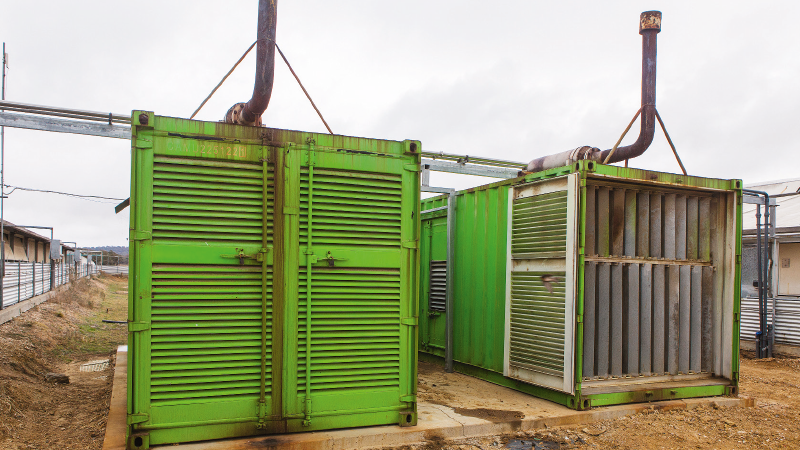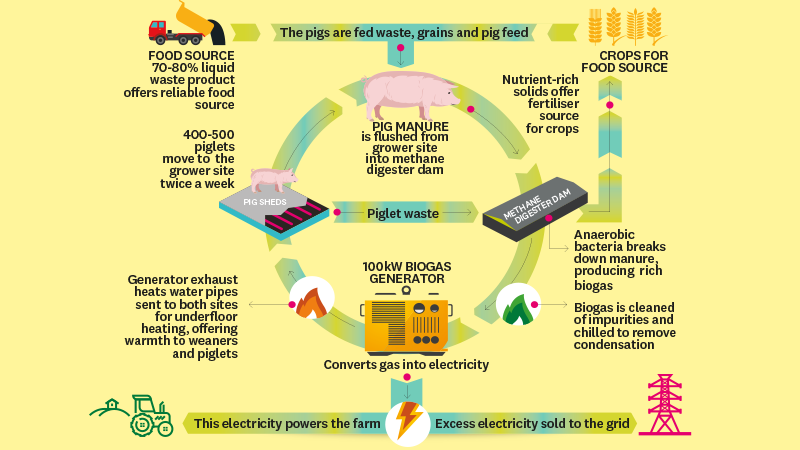AFTER taking over part of the family piggery from her parents in 2007, Edwina Beveridge, together with her husband Michael, doubled its size in just five years. Today,
Blantyre Farms has anywhere up to 25,000 pigs on site at any one time. Pigs are powerhouses built to feed the world, Edwina says. “They’re amazing animals and over their lifetime they’ll gain around 670 grams a day and at the end of their lives they’re growing a kilo a day.”
But powering up that pork also requires a lot of feed and electricity. Edwina has discovered novel solutions for both, saving money and the planet at the same time. She’s turning the pigs’ waste into energy, a clever way to create a sustainable business safeguarded from rising electricity prices – and keeping energy costs down acts as a buffer to fluctuating product demand and changing commodity values. And she’s also scrimping on high-input traditional grain feed, instead converting food that humans don’t need – and there’s mountains of it – into feed for her precious charges.
DWINDLING PORK PROFITS
Edwina and Michael run an intensive 2,200-sow piggery, spread across two sites, Golden Grove (breeder site) and Dead Horse Gully (grower site), 15km from Young in the Riverina. It produces 1,000 piglets each week through artificial insemination, weans at 3.5 weeks and sells 850 pigs, aged about 23-weeks-old each week, averaging 105kg live. As deputy chair of NSW Farmers’ Pork Committee and an
Australian Pork Limited board member for several years, Edwina is well versed on the ins and outs of pork. She acknowledges pig farming is intensive. And, to make matters worse, it is going through a tough time – Edwina says they’ve seen a downturn of about 40%.
“This downturn has been caused by an oversupply from industry growth and improved production,” she says.“Pig farmers have improved their operations and it’s sad that it’s hurting us now. I think we’ll have depressed prices for another 12 months or more and some people won’t make it out the other end. There are big feed bills and high cash turnover, so it’s hard to keep up if you’re not making money,” she says. “It’s a fine balance and doesn’t take much to tip over.
“Our operation is protected to a degree with sufficient electricity and an alternative liquid-based food supply [from waste]. Both those things keep our costs low and put us in a better position during this terrible downturn.”
In 2011, Blantyre Farms began converting pig manure into renewable electricity with the installation of a methane digestion system, a huge feat for their business and a significant investment. The system captures methane gas generated from pig manure, and the gas is then turned into electricity. The system supplies 100% of the farms’ energy needs, with excess sold to the grid, saving the business about $29,000 a month in power and gas bills, and then bringing in $5,700 a month for excess power sold to the grid.
The project took a year to build, with a payback period of two years. And, as a former accountant, Edwina says she was pretty impressed with the financial results, with the piggeries protected from rising power prices – they even benefit from them.
“The real value is not in buying power but providing our own power. I’m happy when the power price goes up, because I get paid more for the power I sell.”
*For further insight about using renewable energy during times of rising power prices, see our story on
David Mailler who’s helping to secure a reliable power supply for rural communities.
 POWER OF METHANE: Blantyre Farms uses digester dams to capture methane which is converted into electricity.
FROM PIG POO TO POWER
POWER OF METHANE: Blantyre Farms uses digester dams to capture methane which is converted into electricity.
FROM PIG POO TO POWER
Pig manure is flushed from the sheds into a large digester dam covered in plastic, which Edwina says “looks like a big jumping castle”. There is a dam at each site and the largest, at the grower site, is 100m long and 40m wide, with a 15-million-litre carrying capacity that takes around three months to fill.
Beneath the plastic, anaerobic bacteria break down the organic matter, producing a methane-rich biogas. The biogas is then cleaned of impurities, including hydrogen sulphide, chilled to remove condensation and used as fuel to operate three 100kW biogas generators to produce electricity.

There are two generators at the grower site and one at the breeder site, all housed in shipping containers that help reduce noise and run 24-7 with remote control access for troubleshooting breakdowns, all managed via computers.
“This means we don’t need someone onsite at all hours of the night,” says Edwina. “We have alarm systems that send us text messages if the generators or the liquid-feed systems stop out of hours, which minimises downtime.”
Most of their power goes to heating their pigs. Hot water, heated by a heat exchanger on the generators’ exhaust, is piped into the weaner rooms to warm weaner pigs at the grower site and under the floor in the farrowing house at the breeder site to provide a warm space for newborn piglets. “This offers an enormous reduction in power consumption.”
The system also reduces the business’ environmental footprint by converting methane, an extremely harmful greenhouse gas, into energy and carbon dioxide.
TURNING WASTE PRODUCTS INTO RICH RESOURCES
The pig manure provides more than just electricity and heating, says Edwina. No waste is wasted. Leftover liquid from the digester dam is reused to flush manure from the shed back into the dam, recycling the waste once again and reducing additional water use.
“The nutrient-rich solids from the digester dam are separated, pumped onto a long contour bank and dried, using the natural energy from the sun. This offers a fertiliser source for our wheat, canola and triticale crops,” she says. “I like to add a little bit in my garden and a little bit for pasture, but mostly crops. That saves us buying synthetic fertilisers.”
Blantyre Farms spans 4,700 hectares and consists of three separate farms, including the two piggery sites. As well as pigs, it produces cattle, sheep and mixed crops, and employs 40 full-time staff. Edwina says almost all of the grain they grow is fed to the pigs, about 2,000 to 3,000 tonnes a year. In addition to this they give the pigs 3,000 tonnes of a dry concentrated pig feed containing vitamins and minerals, and 13,500 tonnes of food waste – most of it liquids – that would otherwise be landfill.
“Most pig operations of our size feed around 7,000 tonnes of grain,” she says – but finding alternative food has helped drought-proof their operation. “Our grain reliance is reduced and we’re protected from fluctuating grain prices during drought periods.” By supplementing it with waste food products, she sees many benefits. “We’re saving huge amounts of landfill, reusing food waste, recycling and turning it into pork. That’s something wonderful. We’re producing safe, nutritious pork and doing it an environmentally friendly way.”
 SWAPPING GRAIN FOR GANACHE
SWAPPING GRAIN FOR GANACHE
Edwina is immensely proud of her piglets and the farm’s resourcefulness in their feeding. Her family has been experimenting with different types of waste products for 30 years and unpacking waste products for 15 years. “We’ve always fed a wet-based product to our pigs, but we’re using less grain than ever before,” she says. They’ve discovered endless opportunities by using wet products, Edwina says. “There are very few people who can handle liquid waste by-products – the only competition is landfill or soil injection.”
On the other hand, there’s lots of competition for dry products, from feedlots and chicken farms. “We deliver our feed like porridge – so, instead of augering, we pump it. Most people deliver dry feed like muesli.” Edwina’s father, Dugald Walker, “a farmer and frustrated engineer”, designed a customised machine about 15 years ago to master the handling and delivery of liquid-based products.
At the grower site, 70-80% of the pigs’ feed comes from food waste. Of this, 8 million litres is waste dairy product or juice, some of which the machine unpacks from plastic, cardboard or tin containers. “We use a lot of dairy product that has passed the use-by date,” says Edwina. “We receive a semi load of packaged dairy products each day. You can pretty much look in the supermarkets’ dairy section – whether it’s yoghurt, custard or milk – and we feed it to our pigs.” Edwina adds the dry feed mix that includes wheat and bread meal, along with an occasional serving of fish fillets and confectionery.
The Beveridges are offered an increasing variety of waste products. “For some, we just pay the freight, or they pay us, or we pay for it at a fee. You’ve just got to work out how much effort there is and how much the pig gets out of it,” says Edwina.
“Once I was offered 70 tonnes of ganache in 20-litre buckets. But the ganache would not come out of the bucket. We’re still churning through this product. There are lots of challenges like this.” She says the products that arrive consistently every week and in big quantities are the winners. But there’s a lot of work in finding the right product.
While the pigs’ menu sounds decadent, Edwina says their elaborate diet has zero effect on the flavour of the meat. “We have a nutritionist who balances their diet and if the by-products are changing, we add vitamins and minerals to ensure they’re receiving the right feed and developing as they’re meant to.”
Capturing and destroying waste from Golden Grove and Dead Horse Gully has dramatically improved the piggery’s environmental footprint. It was the first commercial piggery in Australia (of 20 piggeries now) to adopt this technology, along with carbon accreditation.
“Methane has a global warming potential of 25 times carbon dioxide and we have eliminated this going into the atmosphere,” says Edwina. “Destroying methane has enabled us to generate and sell carbon credits for the last six years.”
Like all animals, pigs produce manure, and a great deal of it, so it seems only natural to Edwina to use the commodity that’s literally right under her nose to generate energy and a reliable source of income. Unlike sheep and cattle, pigs produce their manure in the shed, making it easier to capture it and turn it into electricity.
“We didn’t entirely know what we were doing when we started out. Some parts were complicated, but it really is a simple process once it’s up and running,” she says.
“We had zero assistance from the government. Australian Pork Limited came up with the process [for a biogas generator] and brought in a consultant who supported us with the technical side. We’ve got to keep up with technology and stay ahead of the curve, otherwise you get spat out the other end. There’s a lot going on in this industry – you have to be switched on.”